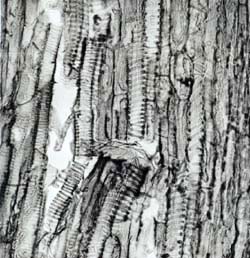Xylem
vessels are long, narrow, hollow tubes containing no
living material and impregnated with bands or spirals of
lignin. Joined end to end, they provide a continuous
pathway from the roots through the stem and to the
leaves. As well as being waterproof, the lignin provides
strength to stop the vessels from collapsing. The narrow
diameters of the xylem vessels increase the capillarity
forces, however once again, this only makes a small
contribution to water's upward movement.
|
 |
Looking at
leaf structure provides the clues to what is the main
force involved in maintaining a continuous flow of water
from root to leaf through the xylem.
In broad
leaved plants, the leaves are large, thin, flat
structures. Large, in order to trap lots of light energy,
and thin so that the carbon dioxide can diffuse into the
leaf from the surrounding air.
|
Examination
of a leaf reveals small pores, or stomata, in the leaf's
surfaces. Each stoma is controlled by 2 guard cells which
"open" and "close" the pore. If the
plant is to obtain sufficient carbon dioxide for
photosynthesis it is necessary that the stomata are open,
however, in being open, water can be lost through these
same stomata by evaporation. It is this evaporation,
known as transpiration, which is the driving force for
pulling water through a plant. In most broad leaved
plants, a greater number of stomata are found on the
cooler, lower surface. This ensures that sufficient
carbon dioxide can enter while at the same time cutting
down the amount of water lost by transpiration.
|

TS Privet
leaf
|